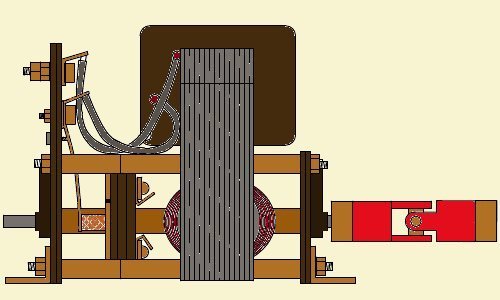Modern radio systems expect to use an electronic speed controller (ESC) to operate the motor, and this usually reverses the input polarity to make the motor go backwards. As we have seen earlier, this will not work for a field-wound motor.
There are a number of ways of addressing this issue. The ones I know about are indicated below – if anyone knows of another method I would be glad to hear about it!
| |
Technique |
Advantages |
Disadvantages |
| |
|
|
|
| 1 |
use non-reversible esc |
Simple |
Provides no reverse! |
| 2 |
use external electrical switch, on an extra servo |
Follows original static Taycol reversing advice |
Uses extra channel, harder to use ergonomically, and allows control to be switched directly from hard forward to hard reverse unless an interlock is incorporated. Needs extra mechanical work. See the Action Electonics unit which lets this function automatically with a reversible ESC. |
| 3 |
use reversible esc with added rectifier. |
Uses current technology, but involves modifying Taycol wiring. Wiring is fairly easy even for for persons unused to electronics. |
Loses some power through the rectifier. Some electrical failures could damage the motor coils, so extra fuses are recommended |
| 4 |
use ESC-driven Relay Reverser |
Follows original Taycol Radio Control advice. Uses a specially designed circuit which must be made up . |
None apparent as yet. A new approach which has been very reliable in testing. Needs the ability to solder up a circuit. |
1 – If you are just going to use a standard ESC, using a non-reversible ESC is more sensible than using a reversible one. A reversible one costs more money, and would give you a strange throttle control, with stop in the middle, full forward at one extreme of the stick and about half-forward at the other! In practice, having no reverse is usually less of a problem for a typical fast boat than it is for a slower scale boat, particularly something which does a lot of manoeuvring, such as a tug...
2 – Taycol instructions from the 1960s suggest adding a changeover switch. These were either going to be hand operated, or relay switches operated by the radios of the day, which demanded a degree of electronic knowledge to install. Modern radios are neither designed to operate hand changeover switches nor relays, but they can perform manual switching if the operator is prepared to put in the mechanical work that is needed. Refer to the
Taycol Documents page for further information on changeover switch wiring. The actual installation will depend so much on the equipment used that there is no point providing further detail here, but the
Servo Reversing page has some suggestions for Taycol-style servo-operated changeover switches...
3 – Another option for mechanical switching is available, in the shape of a PIC microprocessor-controlled reversing switch from Action Electronics. This is a small unit designed to monitor a reversible ESC, and perform a mechanical action when it moves to 'reverse'. Mainly intended for mechanically reversing WaterJet boats or Steam Engines, it could just as easily throw the switch on a Taycol.The disadvantage is that PICs are very sensitive to interference, and old Taycols can push out a lot of this! If you think you can suppress adequately, go to the
Servo Reversing page for further info, as well as some plans for Taycol-style servo-operated switches...
4 - A bridge rectifier (a fairly common cheap electronic component) may be attached to the Taycol motor in such a way as to allow one set of windings to be polarity-reversed when the speed controller reverses, while leaving the other set at the same polarity. A bridge rectifier is usually used to change AC into DC, where the incoming polarity is switched many times a second, but it will work equally well for this application. They come in several different patterns and sizes, but the connections are pretty simple. The disadvantage is that you lose a few volts in the rectifier - but simplicity makes up for that. Go to the
Rectifiers page for further details...
5 - I have produced a simple circuit to do the polarity detection automatically and operate a changeover relay. This would be the closest approximation to the original way that a radio-controlled Taycol would have operated, and appears proof against all interference. The disadvantage is that you need to do some electrical soldering. Go to the
Relay Switching Page for further details.
If you are adding reverse to one of these motors, be careful of the propeller and shaft connections. These motors have high angular momentum and high torque – slamming one into reverse can unscrew connectors or possibly shear the prop shaft.....


